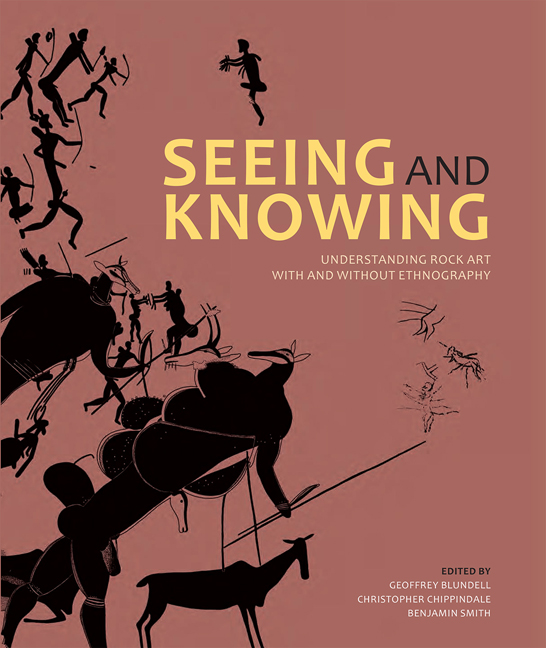Book contents
- Frontmatter
- Dedication
- Contents
- Contributors
- Acronyms
- Chapter 1 Rock art with and without ethnography
- Chapter 2 Flashes of brilliance: San rock paintings of heaven's things
- Chapter 3 Snake and veil: The rock engravings of Driekopseiland, Northern Cape South Africa
- Chapter 4 Cups and saucers: A preliminary investigation of the rock carvings of Tsodilo Hills, northern Botswana
- Chapter 5 Art and authorship in southern African rock art: Examining the Limpopo-Shashe Confluence Area
- Chapter 6 Archaeology, ethnography, and rock art: A modern-day study from Tanzania
- Chapter 7 Art and belief: The ever-changing and the never-changing in the Far west
- Chapter 8 Crow Indian elk love-medicine and rock art in Montana and Wyoming
- Chapter 9 Layer by layer: Precision and accuracy in rock art recording and dating
- Chapter 10 From the tyranny of the figures to the interrelationship between myths, rock art and their surfaces
- Chapter 11 Composite creatures in European Palaeolithic art
- Chapter 12 Thinking strings: On theory, shifts and conceptual issues in the study of Palaeolithic art
- Chapter 13 Rock art without ethnography? A history of attitude to rock art and landscape at Frøysjøen, western norway
- Chapter 14 ‘Meaning cannot rest or stay the same’
- Chapter 15 Manica rock art in contemporary society
- Chapter 16 Oral tradition, ethnography, and the practice of north American archaeology
- Chapter 17 Beyond rock art: Archaeological interpretation and the shamanic frame
- List of figures
- List of tables
- List of publications by david Lewis-williams
- Index
Chapter 6 - Archaeology, ethnography, and rock art: A modern-day study from Tanzania
Published online by Cambridge University Press: 21 April 2018
- Frontmatter
- Dedication
- Contents
- Contributors
- Acronyms
- Chapter 1 Rock art with and without ethnography
- Chapter 2 Flashes of brilliance: San rock paintings of heaven's things
- Chapter 3 Snake and veil: The rock engravings of Driekopseiland, Northern Cape South Africa
- Chapter 4 Cups and saucers: A preliminary investigation of the rock carvings of Tsodilo Hills, northern Botswana
- Chapter 5 Art and authorship in southern African rock art: Examining the Limpopo-Shashe Confluence Area
- Chapter 6 Archaeology, ethnography, and rock art: A modern-day study from Tanzania
- Chapter 7 Art and belief: The ever-changing and the never-changing in the Far west
- Chapter 8 Crow Indian elk love-medicine and rock art in Montana and Wyoming
- Chapter 9 Layer by layer: Precision and accuracy in rock art recording and dating
- Chapter 10 From the tyranny of the figures to the interrelationship between myths, rock art and their surfaces
- Chapter 11 Composite creatures in European Palaeolithic art
- Chapter 12 Thinking strings: On theory, shifts and conceptual issues in the study of Palaeolithic art
- Chapter 13 Rock art without ethnography? A history of attitude to rock art and landscape at Frøysjøen, western norway
- Chapter 14 ‘Meaning cannot rest or stay the same’
- Chapter 15 Manica rock art in contemporary society
- Chapter 16 Oral tradition, ethnography, and the practice of north American archaeology
- Chapter 17 Beyond rock art: Archaeological interpretation and the shamanic frame
- List of figures
- List of tables
- List of publications by david Lewis-williams
- Index
Summary
TANZANIA: rock art and ethnography
Wherever hunter-gatherers lived and there is rock, rock art exists. Rock art research in Tanzania has not been carried out as extensively or as systematically as in South Africa. Some early works were by colonial administrators and officials (e.g. Bagshawe 1923; Culwick 1929, 1931; Aitken 1948; Fosbrooke et al. 1950; Fozzard 1959). Later, the documentation of rock art was an outcome of research in other fields, such as in the doctoral studies of Fidelis Masao (1979) on the Later Stone Age of central Tanzania and that of Eric Ten Raa (1967) on Sandawe oral literature. My own study is one of the few that was conceived and directed at specifically exploring the rock art found among the Sandawe people (Lim 1992). This gives a limited body of data from which to work – both in terms of ethno - graphy and archaeology (rock art studies). This chapter suggests the need to re-evaluate methodologies and theories in the Tanzanian context, given its embryonic stage of study. South African rock art practices are valuabl e as a guide, but interpretations should not be limited only to those noted there; research requires being open to alternative possibilities.
The work of David Lewis-Williams and the University of the Witwatersrand's Rock Art Research Institute has dramatically changed how rock art research is undertaken – in emphasising the use of ethnography, and in its understanding of images as metaphors and symbols. As Lewis-Williams and others developed methodologies and theories over the past three decades (Lewis-Williams 1983; Dowson & Lewis-Williams 1994), extensive areas of southern Africa were investigated, with many paintings discovered and documented. A constantly expanding body of data allowed for the continued testing and refining of interpretations. Since the 1960s, rock art studies have matured and become an established sub-discipline of archaeology – a study accepted and popularised worldwide. South Africa is one of the few countries that is as rich in rock art sites as it is in the number of researchers actively engaged in rock art studies.
- Type
- Chapter
- Information
- Seeing and KnowingUnderstanding Rock Art With and Without Ethnography, pp. 98 - 115Publisher: Wits University PressPrint publication year: 2010



